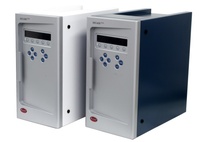CHRONECT Workstation MOSH/MOAH
Complete workstation for the determination of mineral oil contaminants in food, feed, packaging and cosmetics.
The analysis of MOSH/MOAH is performed with an online LC-GC-FID coupling. In this process, a HPLC is connected to a GC via a special interface. The GC uses FIDs as detectors because they show a uniform response for hydrocarbons. This is the only way to quantitatively determine the sum of all individual components. Optionally, mass spectrometers can also be used for detection. The aim is usually to be able to make qualitative statements about single substances.
Undesirable mineral oil residues are found in numerous foods or food contact materials: Saturated hydrocarbons (MOSH - mineral oil saturated hydrocarbons) and aromatic hydrocarbons (MOAH - mineral oil aromatic hydrocarbons). While the first substance class accumulates in the human body, the second compound class is suspected to contain carcinogenic substances. These substances can enter food through numerous contamination pathways. In 2009, the Federal Institute for Risk Assessment in Germany (BfR) confirmed that these substances are harmful to health. In its assessment, the BfR concluded that the transition from mineral oils to food should be urgently minimized. Measurements are recommended.
System configuration
The analysis of MOSH/MOAH is performed with an online LC-GC-FID coupling. In this process, a HPLC is connected to a GC via a special interface. The GC uses FIDs as detectors because they show a uniform response for hydrocarbons. This is the only way to quantitatively determine the sum of all individual components. Optionally, mass spectrometers can also be used for detec-tion. The aim is usually to be able to make qualitative statements about single substances.
The coupling is done via an interface, which consists of a control unit and a heated valve unit. The temperature of the valve unit can be varied from room temperature to 150°C. The temperature control effectively prevents condensation of the HPLC solvent in the valve unit and improves the stability of the system. An integrated flushing of the valve unit with carrier gas prevents tailing of the solvent and possible carryover.
HPLC consists of a pump and a UV detector, which is used to check the HPLC chromatogram and to verify the correct fractionation. The gas chromatograph is equipped with two FIDs.
This 2-channel setup, developed by Axel Semrau, allows the simultaneous determination of MOSH and MOAH in one GC run, thus halving the analysis time.
In HPLC, the substance groups MOSH and MOAH are separated. After separation, the fractions are transferred completely to the GC. In this transfer, 450 µL of solvent per fraction are introduced into the GC and removed by evaporation via the interface before the gas chromatographic separation.
The CHRONECT Workstation MOSH/MOAH can be configured based on devices by the manufacturers Agilent or Shimadzu.
The control of the entire system is done user-friendly by the software CHRONOS by Axel Semrau. Options such as automatic epoxidation or online aluminium oxide purification can be selected simply by clicking in the sample list for the respective sample.
Advantages of measuring with the CHRONECT Workstation MOSH/MOAH:
- Halved analysis time due to 2-channel setup for simultaneous determination of MOSH and MOAH
- Removal of interferences by means of epoxidation and AlOx-Cleanup
- Options such as GCxGC-MS analysis or MOSH depletion available
- Specialized software for the evaluation of Humps
- Specially trained support team
- System setup based on over 11 years of experience with MOSH/MOAH analysis
- Continuous development in cooperation with over 185 customers
|
Technical data - Specifications |
Values |
|
MOSH/MOAH measuring system us-ing LC-GC-FID according to DIN EN 16995, supports DGF C-VI 22 (20) |
Includes HPLC with UV detector, GC with 2 FIDs and oven chamber illumination, CHRONECT Robotic Autosampler, LC-GC-Interface, consumables for 6 months, data system for evaluation, Factory Acceptance Test, installation and Site Acceptance Test |
|
Number of LC-GC channels |
2 channels, optionally expandable to 3 |
|
Temperature valve unit |
Room temperature up to 150 °C, typical operating temper-ature 120 °C |
|
Option: automatic epoxidation |
supports ethanolic epoxidation according to Nestola, com-pliant with DGF C-VI 22 (20) |
|
Option: online aluminium oxide cleanup |
Includes additional pump, valve set and matching columns |
|
Supported Hardware |
Agilent 8890 GC, Agilent 1260 Infinity II, Shimadzu GC- |

